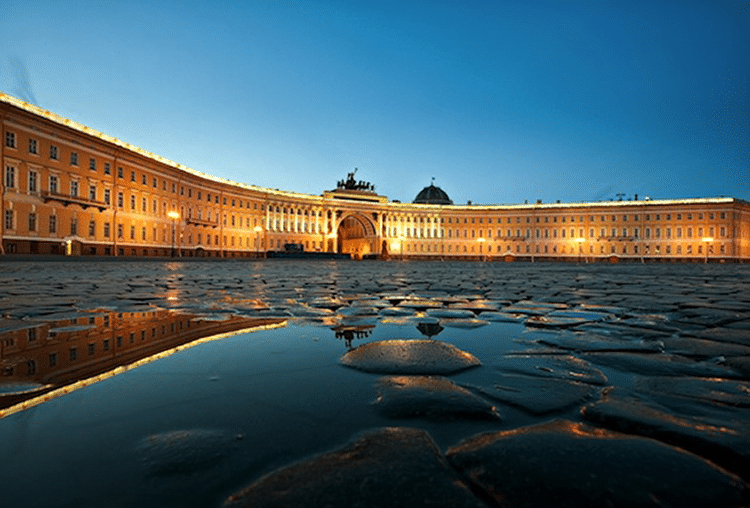Many of you know something about St. Petersburg but few of you know its secrets. Moscow’s little sister but perhaps Russia’s real capital at least in terms of culture, it’s a city that exudes the feeling of the artists, writers and poets that made it great. After years under Communist influence, today it has baby-stepped its way back to its former glory, a dazzling destination showing off the all the qualities that made it an imperial city. While it has earned the moniker, The Venice of the North, thanks to the many canals weaving their way in and around the city center, aside from the waterways and alliances with creative individuals in the fields of music and architecture, the two cities are vastly different.
“Well, it rains almost all the time in St. Petersburg,” Lisa, our perky Muscovite guide had said a few days earlier when she met us at the Moscow airport and learned that we were planning a visit. It was almost the middle of May and I started getting nervous. “Don’t let it dampen your spirits,” she said not realizing the irony in her remark. However, Lisa wasn’t dead on accurate because when we arrived it had just stopped raining and the sun was shining.
“St. Petersburg is an intellectual city” said Alla our host as she escorted us from the station to the Hotel Astoria. Having taken the high-speed train from Moscow (and paying the premium for first class tickets), we came to the conclusion it was worth the extra investment. The landscape had sped by while we relaxed in large, comfortable seats enjoying cocktails and a hot meal. When we pulled into the grand old train station which I thought resembled Berlin’s obsolete Templehof Airport, I was reminded of the city’s Soviet past. Outside St. Petersburg bustled with traffic and taxis and the ancient structures surrounding the square were still wet and dappled with sunshine.
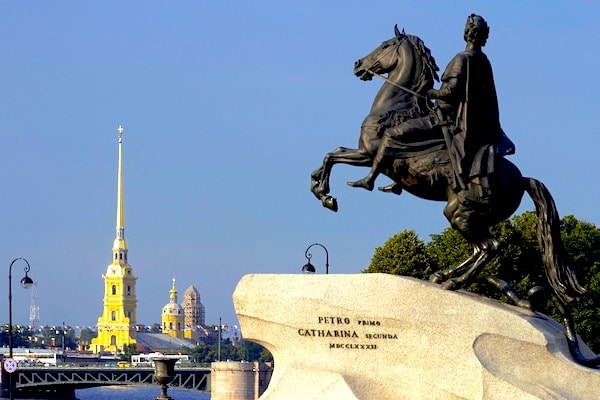
The Hotel Astoria was the perfect setting to take a step back in time even though its accommodations have been transformed to a modern level of sophistication. The marble lobby’s crystal chandeliers hinted at opulent receptions and visiting heads of state and the hallways were right out of a Fred & Ginger film. I wanted to dance down them. Our chic suite was decorated with green accents and reproductions of furnishings from the deco days. A baby grand off the lobby was played during tea at the Rotunda salon and on the walls of the Lichfield Bar, the discrete lounge tucked away from prying eyes, vintage photos by English superstar photographer, Lord Patrick Lichfield, captured some of our favorite celebs from days gone by.
St. Petersburg’s pedigree owes a lot to Catherine the Great and at times it feels like Paris but on a much smaller scale. As Russia’s cultural capital, it was a Mecca for writers, composers and dancers such as Pushkin, Dostoevsky and Tolstoy, Tchaikovsky and Rimsky-Korsakov and Baryshnikov and Nijinsky. Now we were exploring the same streets and neighborhoods as those artists of long ago and channeling their aura. It was easy to see why they were attracted to the ambience. It was springtime and the city was beautiful in the sunlight with its Mediterranean colored buildings of yellow, pink and mint. And as the sun wasn’t setting until 11 pm, the wide streets and avenues were crowded with people.
The next morning Alla arrived to escort us to the Peter and Paul Fortress, one of the city’s prime attractions. She was wearing a yellow raincoat and carrying an umbrella; the rain was back. It was just a short walk so we grabbed our umbrellas and started off. For the most part, St. Petersburg is a walking city and it’s the best way to reach many of the major sights. Built by Peter the Great in 1703, the fortress was the city’s original citadel. Occupying a large area on an island across the Neva River, the complex offers up an assortment of historical structures including a cathedral, the still functioning mint and a dark and solitary prison which offers a solemn tour that takes you through the cells of some of the more well-known political prisoners. The fortress is a page out of Dostoyevsky’s “Crime and Punishment.” We visited the cathedral, where most of the czars are buried leaving Alla outside in the drizzle but when we exited the rain had stopped again.

After a morning of history we needed to change it up. Keeping to our theme of water, we found ourselves at Dozari for lunch, a floating restaurant installed on a boat moored in the Neva River. The restaurant has a vibrant red interior illuminated by large windows framing killer water views of much of the city. Even in the drizzle Dozari exuded an electric energy and I got the impression that at night the atmosphere would be ripe for partying. Stellar food turned out by their inventive chef is decidedly modern Russian cuisine and their cocktail program and homemade infusions showed off the boundless Russian creative energy. After sipping a Chatelet and a J.D., it was easy to forget the rain.

Everyone knows that the famous State Hermitage Museum on the banks of the Neva River is the jewel of St. Petersburg with art and sculpture from all over the world. Built in 1764 and comprised of six buildings, one of which is the Winter Palace, this is where Catherine lived when she was in the city. It’s massive! You could easily spend a whole day here taking in the 3 million+ collection. Do yourself a favor and spring for a private tour for insight on the palace and the permanent collections. You’ll quickly be joining the crowds fawning over Italian Renaissance paintings, works by the Dutch Masters including quite a few Rembrandts, and Impressionist and Fauvist pieces from Matisse and Picasso. There’s also a stunning selection of Egyptian, Hellenistic and prehistoric works and an automated Peacock Clock from 1781 that was owned by Catherine herself and is not only a gorgeous sight but also a wonder of engineering.
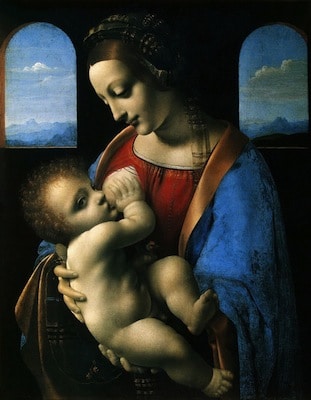
A nice way to balance the historical references with Russian culture today is to spend a little time touring the ERARTA museum. Here, you’ll discover where the art scene is now and where it’s going. Russians are still coming to terms with what modern art is all about and this boutique museum offers a chance to appreciate Russian contemporary art from the time it was banned in the Soviet period to the present. Taking a novel approach to the genre, the museum includes “YOU” rooms where one can experience art and interact with it. The café in the basement has a great menu, too, for lunch before or an early supper.
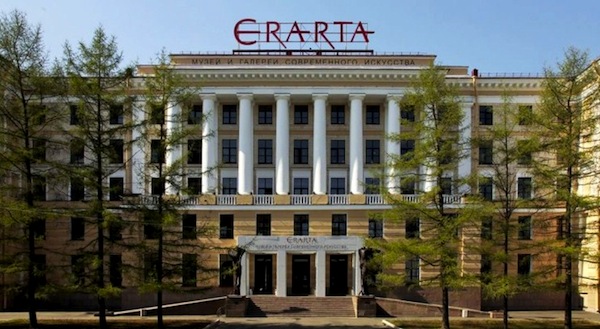
For the second part of our stay in St. Petersburg we were fortunate to occupy the princely chambers at the Four Seasons Lion Palace Hotel. This mustard colored former palace has quite a theatrical lobby with a “big entrance double staircase” and an unusual display of 5-foot tall flower vases arranged on the floor in a kind of viewing area off the reception. It’s quite a sight! The buds are changed daily and were a constant reminder of the hotel’s grandeur. Accommodations are similarly grand and oversized and include Bulgari amenities.
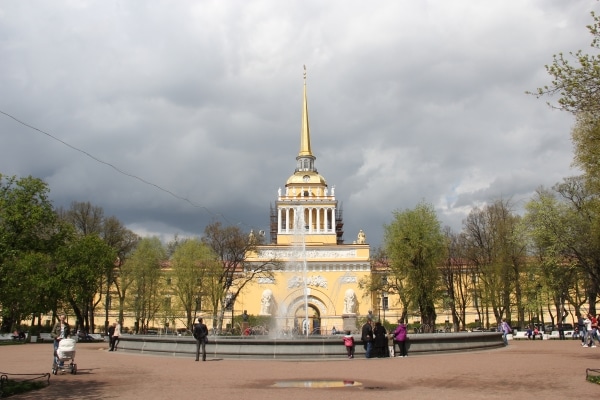
We took a stroll up the Nevsky Prospekt after our hotel move. The most famous street in St. Petersburg was built by Alexandre Jean Baptiste LeBlond and commissioned by Peter the Great who intended it to be the Champs Elysees of the city not to mention a promenade for many of the cultural luminaries of the time. The busy commercial street starts at the Admirality, the former naval headquarters, and goes all the way to the railway station. Much of Petersburg’s shopping and nightlife happens here and there are canals that intersect the boulevard. Don’t miss the bookstore with the Art Nouveau roof and façade.
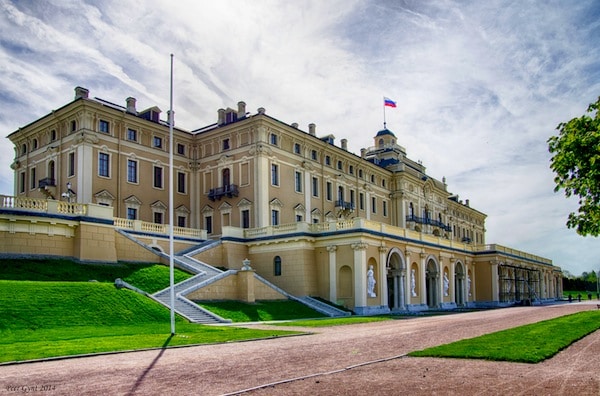
The Church of the Savior on Spilled Blood is one of those must see landmarks in Petersburg, built as it is on the site where Tsar Alexander II was assassinated. The famous church is one of the city’s major visuals like the Eiffel Tower, the Statue of Liberty or Christ the Redeemer in Rio. It’s a spectacular example of the medieval Russian style with onion domes in gold, red and blue and it’s sitting right beside the Griboedov Canal, which runs perpendicular to Nevsky Prospekt. The interior contains the best example of Russian bling ever, with gold adorned altars and mosaics of magnanimous proportions. Seeing people standing on line in the rain, waiting to get in for a glimpse of the spectacle was a memorable experience.

After all the history and culture touring, a stop at the Museum of Russian Vodka will uplift your spirits especially if it’s raining outside. It’s definitely worth springing for the guided tour here which takes only about thirty minutes and includes a glimpse into what it was like during prohibition in the Soviet period (not fun). You’ll not only learn how Russian’s famed grain spirit is made and its place in Russian culture but you’ll also get to drink a flight of three of the best Russian marques accompanied by savory snacks at the tour’s end. The museum has a fantastic restaurant adjacent where you can have a complete meal and try one or more of the almost 300 vodkas on the menu. Russian specialties like Chicken Kiev and Borscht are top choices.
Even the shortest stay in St. Petersburg needs time allotted to see a ballet at the famous Mariinsky Theatre, the home of the Kirov Ballet. The ante-area to the theatre is painted a deep mint green and the interior sports traditional opera chair style seating, quite different from U.S. theatres. Be sure to have some small bills on hand for refreshments during the intermissions as none of the concessions have any change. Before departing you can easily find out what will be playing when you’re there and purchase tickets as well.
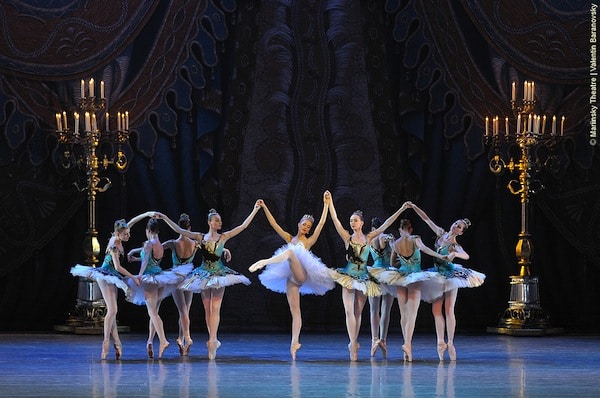
Thinking about St. Petersburg and the intellectual people that have been drawn to it in years past, one can see how the city is again alive with creative energy. Visitors young and old alike will feel this sipping a cocktail at Dozari or downing a vodka at The Idiot. St. Petersburg has been reborn and its beauty is alluring. You’ll get used to the rain!
Hotel Astoria—Located in the heart of St. Petersburg, this hotel has been a city landmark since its construction in 1912. The hotel’s striking Art Nouveau architecture has attracted high profile clients like Lenin, Rasputin, and HG Wells. Bolshaya Morskaya 39, St. Petersburg 190000 Russia; +7 812 494 5757; www.roccofortehotel.com/hotel-astoria/
Four Seasons Lion Palace Hotel—Live like royalty at the Four Seasons, which is housed in a 19th century royal palace. From the beautiful views of Aleksandrovsky Garden to the four-level spa, this place oozes luxury. Don’t miss afternoon tea at the Tea Lounge, a glass roofed building situated in the middle of the former palace’s gardens. Voznesensky Ave, 1, St, Petersburg; +7 812 339 80 00; www.fourseasons.com/stpetersburg/
Where to Eat:
The Idiot—Eating at this cozy restaurant, named after Dostoevsky’s The Idiot, feels like being invited to dinner at a 19th century Russian home stocked with bookshelves and antique furniture. The traditional Russian fare adds to the authentic feel. Naberezhnaya Reki Moyki, 82, St. Petersburg; +7 812 315 16 75; www.idiot-spd.com
Stroganoff Steak House—This steakhouse is named after the classic dish, beef stroganoff, which was created in St. Petersburg by the benevolent Count Stroganoff in the 18th century. The rusted horseshoes on the walls recall the building’s former life as Catherine the Great’s stables. Konnogvardeysky Blvd., 4, St. Petersburg; +7 812 314 55 14; www.stroganoffsteakhouse.ru
Dozari – Talk about surprises! Installed on a boat moored at the Neva River’s edge with a birds-eye view of St. Petersburg, the aim of this place is to take you far away from the mundane. Plan on settling back for awhile after chowing down on a halibut filet with pumpkin puree. Be sure to sample the bar’s amazing fusion cocktails, like the J.D. and Chatelet. 14a Dobrolubova pr., St. Petersburg; +7 812 928 60 70; www.dozaribar.ru
What to See & Do:
State Hermitage Museum—You could easily spend an entire day viewing the 3 million artifacts and works of art housed at the State Hermitage. The museum includes stunning historic buildings as well, including the Winter Palace, former state residences of old Russian Emperors, and the Hermitage Theatre. Palace Square, 2, St. Petersburg; +7 812 710 90 79; www.hermitagemuseum.org/
Peter and Paul Fortress—Built by Peter the Great in 1703, this fortress is the original citadel of St. Petersburg. A central part of the State Museum, this is the perfect place to explore St. Petersburg’s rich and fascinating history. St Petersburg 197046; +7 812 230 64 31; www.spbmuseum.ru/peterpaul_fortress/
St. Isaac’s Cathedral—A must see on any St. Petersburg visit, this stunning cathedral is the largest orthodox cathedral in the world. With its massive domes, columns of semiprecious stone, and intricate mosaics, St. Isaac’s Cathedral is certainly one of the world’s most beautiful cathedrals as well. 1 pl. Isaakievskaya, Admiralteisky, St. Petersburg, 190000; +7 812 315 97 32; www.cathedral.ru/
[caption id="attachment_23678" align="alignnone" width="482"]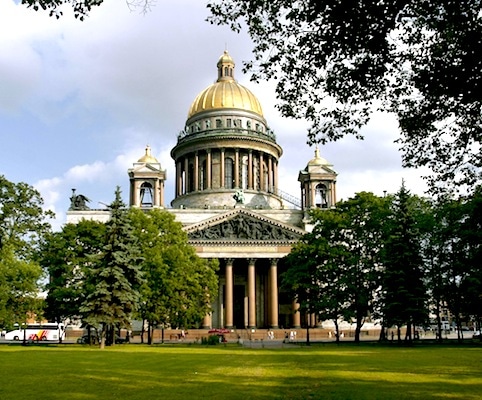 St. Isaak’s Cathedral[/caption]
St. Isaak’s Cathedral[/caption]
Museum of Russian Vodka—The first museum in the world dedicated solely to vodka, this quaint museum shows the great role that vodka has played in Russian culture since it was first made in a 14th century monastery. After learning all about vodka’s history, head to the museum’s restaurant, Russian Vodka Room No. 1, for some Russian cuisine and vodka tastings. Konnogvardeysky Blvd, 4, St. Petersburg; +7 812 570 64 22; www.vodkamuseum.ru
ERARTA Museum of Contemporary Art—The largest private museum of contemporary art in Russia, ERARTA has been dedicated to promoting native Russian artist since its opening in 2010. In addition to its 2,300 works of art, the museum also hosts plays, concerts, film screenings, lectures, and other cultural events. 29th Line,Vasillievsky Ostrov, 2, St. Petersburg; +7 812 324 08 09; www.erarta.com/
[caption id="attachment_23669" align="alignnone" width="600"]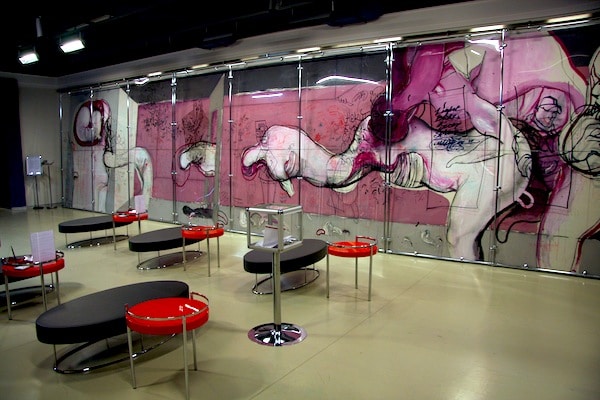 Erarta Museum[/caption]
Erarta Museum[/caption]
Mariinsky Theatre—Since it opened in 1860, the Mariinsky Theatre has been hosting premiere performances. Today, it’s the home to the renowned Mariinsky Opera & Orchestra and the Kirov Ballet. Teatralnaya polshchad, 1, St. Petersburg; +7 812 326 41 41; www.mariinsky.ru/en
Peterhof Summer Residence—This property, once the summer home of Peter the Great, is nicknamed the “Russian Versailles” for good reason. From the elaborate fountains scattered throughout the gardens to the grand paintings decorating the Grand Palace, Peterhof is the epitome of imperial luxury. Razvodnaya, 2, Peterhof; +7 812 450 52 87www.saint-petersburg.com/peterhof
[caption id="attachment_23676" align="alignnone" width="600"]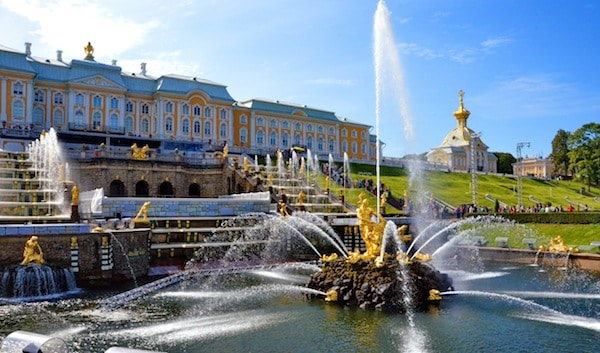 Peterhof Summer Residence[/caption]
Peterhof Summer Residence[/caption]
Tsarskoe Selo—Empress Catherine I first developed this palace into an imperial residence in the 1700s and the property still retains her signature touch today. The light blue and white façade of “Catherine’s Palace” has become a Russian icon. 7 Sadovaya St., Pushkin, St. Petersburg; +7 812 465 94 24; http://eng.tzar.ru/
[caption id="attachment_23681" align="alignnone" width="600"]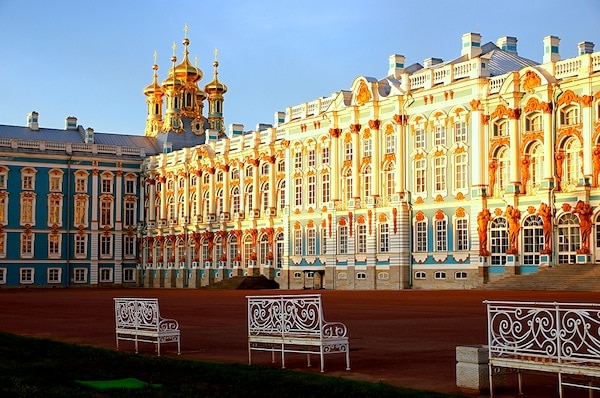 Tsarskoe Selo[/caption]
Tsarskoe Selo[/caption]

